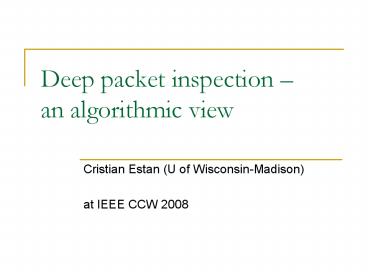Deep packet inspection an algorithmic view - PowerPoint PPT Presentation
1 / 7
Title:
Deep packet inspection an algorithmic view
Description:
Exploiting hardware parallelism. Slow path/fast path solutions. Compressing transition tables ... 1. Can hardware parallelism lead to ideal solution? ... – PowerPoint PPT presentation
Number of Views:100
Avg rating:3.0/5.0
Title: Deep packet inspection an algorithmic view
1
Deep packet inspection an algorithmic view
- Cristian Estan (U of Wisconsin-Madison)
- at IEEE CCW 2008
2
Algorithms matter
- Even non-software solutions using FPGAs and
ASICs run algorithms - Ideal solution not clear if/when we can get
there - Memory increases linearly with of sigs (unlike
DFAs) - Complex sigs can contribute more than simple ones
- Processing constant as of sigs increases
(unlike NFAs) - No slowdown (except that larger memories may be
slower) - No increase in power usage (except for the bigger
memories) - Processing n bytes at a time costs the following
- Up to n-fold increase in memory bandwidth and
processing - No increase in memory size (exponential for naïve
algorithm) - No increase in latency (should be same as for 1
byte)
3
Some general algorithmic ideas for regex matching
in DPI
- Exploiting hardware parallelism
- Slow path/fast path solutions
- Compressing transition tables
- Using auxiliary variables with DFAs
4
1. Can hardware parallelism lead to ideal
solution?
- Match input against multiple sigs independently
- NFA-based solutions for matching a single sig
with breadth-first traversal of states can also
exploit parallelism - Advantages
- Area increases linearly with of sigs
- No slowdown as of sigs increases
- Challenges when of sigs gets large
- Power consumption goes up
- On-chip communication becomes more costly
5
2. Can slow path/fast path lead to ideal solution?
- A simpler version of sigs (e.g. string matching)
is processed in the fast path and if needed, a
more complex version in the slow path - Advantages
- Can use algorithms that scale well in memory and
processing in the fast path - Can use different technology algorithm for
slow path - Challenges
- Algorithmic complexity attacks may trigger the
slow path so often that the system cannot keep up - Measuring performance on traces not enough, must
quantify worst-case performance an adversary can
trigger
6
3. Can transition table compression lead to ideal
solution?
- Exploit the fact that transition tables for
different states are similar (D2FAs) or that many
characters are treated similarly (alphabet
compression tables) - Advantages
- Easy to achieve savings up to a point
- Works even better for multi-byte matching
- Challenges
- Slowdown in matching too big if compression too
complex - Memory still increases when doing multi-byte
matching - Does not help to reduce number of states
7
4. Can DFAs auxiliary variables lead to ideal
solution?
- Associate with some DFA states programs
manipulating auxiliary variables - DFAs become simpler, no state space explosion
- Advantages
- Memory ( of states) increases linearly with
sigs - Processing increases only slightly with of sigs
- Disadvantages
- Average program length increases (slowly) with
of sigs - Algorithmic complexity attacks can cause (small)
slowdown - Does not solve multi-byte matching































